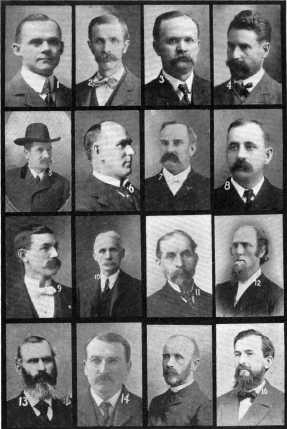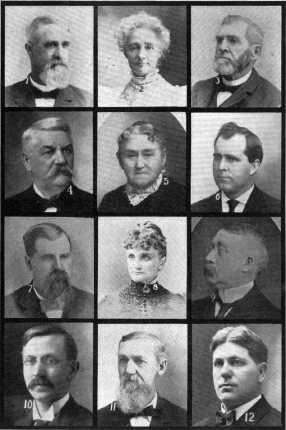
|
556 |
HISTORY OF NEBRASKA METHODISM. |
ants' and Episcopal Funds, and the collection for General
Conference expenses are included in the benevolences for
convenience, neither of them are properly there, as their support
is not a benevolence.
These figures include only the Conference
collections, and do not embrace all the amounts raised by
subscriptions for college and seminary buildings, hospital, and
other such institutions, though in a few cases some of these may
have been reported.
While these statistics for the entire period of
fifty years have been carefully compiled, and we have reason to
believe are substantially correct, they are not absolutely so.
There are occasional errors in the Minutes as published, and there
is no way of correcting them. But these errors are of such a
nature that they are as likely to occur on one side as another,
and in the course of fifty years tend to balance each other.
It should be further explained that nearly all
the benevolences have begun their existence since the beginning of
Nebraska Methodism. This is true of Freedmen's Aid, which began
after the war; Church Extension began in the later sixties;
Woman's Foreign Missionary Society began in 1869, and Woman's Home
Missionary Society in 1880. We had no institution of learning till
1880. Missions and Bible Cause were about all there were at the
first. So with the exception of Missions and Bible Cause, Tract,
and Sunday-school work, these contributions for benevolences have
all been made in the last twenty-five or thirty years.
At the close of our half-century we find
ourselves with 393 full members of Conference and forty-three on
trial. Of these, twenty-three are supernumerary and fifty-nine

LAY DELEGATES TO THE GENERAL CONFERENCE.
1. BAYARD H.
PAINE. 2. GEORGE H.
HORNBY. 3. L. S.
FEIGENBAUM.
4. M. C. HAZEN. 5.
WM. W. HASKEL. 6.
JOHN N. DRYDEN. 7.
W. H. WESTOVER.
8. JOHN A. SLATER.
9. S. A. D. HENLINE. 10.
JOHN DAVIS. 11. A.
J. ANDERSON.
12. W. G. OLINGER. 13.
JOHN J. DOTY. 14. F.
E. SALA. 15. JOHN
DALE. 16. E. H.
ROGERS.
36
557
|
558 |
HISTORY OF NEBRASKA METHODISM. |
superannuated. This leaves 311 effective, of whom
fourteen are presiding elders, and forty are missionaries to the
Territories or to foreign fields, or in some other special
service, as Conference evangelists, or attending school. This
leaves 257 effective preachers as pastors.
We have, according to the Minutes of 1903,
51,697 full members, and 3,354 probationers. These are divided
into 399 different charges, with 257 effective members of
Conference to man them, leaving 142 charges to be supplied
otherwise. This is largely done with our reserve force of 158
local preachers, many of whom are in this way being tested before
being presented to Conference for admission on trial. A few
charges are supplied by supernumerary preachers, and some even by
the superannuated.
There are very few of our 574 church buildings
in which there is not at least one Gospel sermon preached each
Sabbath, and in nearly all there are two sermons preached. It
would not be far from the truth to say that there are 1,000
sermons preached in Nebraska by Methodist preachers every Sabbath
day at the regular services, or 52,000 in the course of the year.
Besides these there are probably not less than 5,000 preached at
revivals and camp-meetings.
In the 690 Methodist Sunday-schools in the State
there are not less than 3,000 teachers giving lessons every
Sabbath from the Divine Word of God. If this is what Methodism is
now doing in a single year, what a magnificent aggregate of
earnest, efficient effort must the entire half-century
present!
Add to these the means of grace as found in the
prayer and class meeting, and Epworth League devotional meet-

LAY DELEGATES TO THE GENERAL CONFERENCE.
1. D. KING. 2. MRS. M. D. NICKELL. 3. A. F. COON. 4. M. B. REES.
5. MRS. M. E. ROBERTS. 6. J. L. McBRIEN. 7. D. C. FLEMING.
8. MRS. ANGIE F. NEWMAN. 9. B. L. PAINE. 10. JOHN W.
BALSON. 11. N. R. PERSINGER. 12. CHAS. A. GOSS.
559
|
560 |
HISTORY OF NEBRASKA METHODISM. |
ings, and we have some idea of the visible means by which
Methodism has been and is now trying to do her part in
evangelizing the State, saving souls, and helping to make the
world better.
Some of the results of all these sermons,
lessons, prayer and class meetings, together with her revivals,
schools, hospitals, and other forms of Christian effort and
helpful institutions, we have been able to place before the eye in
tangible form.
But perhaps the best and most lasting results
are the invisible. The truth lodged in the heart and growing
secretly, bearing the rich fruitage of pure thoughts, high
resolves, noble purposes, and these ultimating in strong clean
character and noble living. The word of sympathy that has inspired
the wavering soul with new courage, brought hope to the despairing
and stanched the tears of sorrow are results incapable of
expression in language or statistics and must await the eternities
for their full expression.
Many of the agencies that brought about much of
these results, both visible and invisible, have themselves been
obscure ministers and laymen who have wrought for years with
little or no recognition. It has been my purpose to bring to light
as many of their achievements as possible, but I have found it
impossible to do justice to all. But among these are to be found
some of our choicest spirits, our noblest heroes. Their lot is
well described by Dean Farrar in these true words: "There is yet a
harder and a higher heroism - to live well in the quiet routine of
life; to fill a little space because God wills it; to go on
cheerfully with a petty round of little duties, little occasions;
to accept unmurmuringly a low position; to smile
|
HISTORY OF NEBRASKA METHODISM. |
561 |
for the joys of others when the heart is aching; to banish all ambition, all pride, all restlessness in a single regard for our Savior's work. To do this for a lifetime is a greater effort, and he who does this is a greater hero than he who for one hour storms a breach, or for one day rushes undaunted in the flaming front of shot and shell. His works will follow him. He may not be a hero to the world, but he is one of God's heroes; and, though the builders of Nineveh and Babylon be forgotten and unknown, his memory shall live and be blessed."